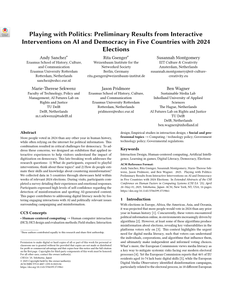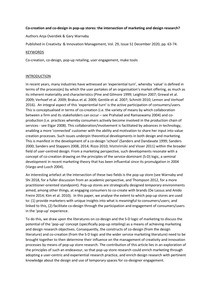In this paper we explore the influence of the physical and social environment (the design space) son the formation of shared understanding in multidisciplinary design teams. We concentrate on the creative design meeting as a microenvironment for studying processes of design communication. Our applied research context entails the design of mixed physical–digital interactive systems supporting design meetings. Informed by theories of embodiment that have recently gained interest in cognitive science, we focus on the role of interactive “traces,” representational artifacts both created and used by participants as scaffolds for creating shared understanding. Our research through design approach resulted in two prototypes that form two concrete proposals of how the environment may scaffold shared understanding in design meetings. In several user studies we observed users working with our systems in natural contexts. Our analysis reveals how an ensemble of ongoing social as well as physical interactions, scaffolded by the interactive environment, grounds the formation of shared understanding in teams. We discuss implications for designing collaborative tools and for design communication theory in general.
MULTIFILE

More people voted in 2024 than any other year in human history, while often relying on the internet for political information. This combination resulted in critical challenges for democracy. To address these concerns, we designed an exhibition that applied interactive experiences to help visitors understand the impact of digitization on democracy. This late-breaking work addresses the research questions: 1) What do participants, exposed to playful interventions, think about these topics? and 2) How do people estimate their skills and knowledge about countering misinformation? We collected data in 5 countries through showcases held within weeks of relevant 2024 elections. During visits, participants completed a survey detailing their experiences and emotional responses. Participants expressed high levels of self-confidence regarding the detection of misinformation and spotting AI-generated content. This paper contributes to addressing digital literacy needs by fostering engaging interactions with AI and politically relevant issues surrounding campaigning and misinformation.
MULTIFILE

Co-creation as a concept and process has been prominent in both marketing and design research over the past ten years. Referring respectively to the active collaboration of firms with their stakeholders in value creation, or to the participation of design users in the design research process, there has arguably been little common discourse between these academic disciplines. This article seeks to redress this deficiency by connecting marketing and design research together—and particularly the concepts of co-creation and co-design—to advance theory and broaden the scope of applied research into the topic. It does this by elaborating the notion of the pop-up store as temporary place of consumer/user engagement, to build common ground for theory and experimentation in terms of allowing marketers insight into what is meaningful to consumers and in terms of facilitating co-design. The article describes two case studies, which outline how this can occur and concludes by proposing principles and an agenda for future marketing/design pop-up research. This is the peer reviewed version of the following article: Overdiek A. & Warnaby G. (2020), "Co-creation and co-design in pop-up stores: the intersection of marketing and design research?", Creativity & Innovation Management, Vol. 29, Issue S1, pp. 63-74, which has been published in final form at https://doi.org/10.1111/caim.12373. This article may be used for non-commercial purposes in accordance with Wiley Terms and Conditions for Use of Self-Archived Versions. LinkedIn: https://nl.linkedin.com/in/overdiek12345
MULTIFILE

There has probably never been such an intense debate about the layout of the countryside as the one that is currently raging. There are serious concerns about the landscape, which is being rapidly transformed by urbanization and everything associated with this process, and not only in the Netherlands but also far beyond its borders. Everyone has something to say in this society-wide debate, from local to national governments, from environmental factions to the road-user's lobby, and from those who are professionally involved to concerned private parties. In many cases it is a battle between idealized images and economic models, between agricultural reality and urban park landscapes, between ecological concerns and mobility. This issue of OASE explores the potential significance of architectonic design for transformation processes on the regional scale. Besides considering the instruments that are available to the designer to fulfil this task, the authors also consider how the design can exercise a 'positive' influence on such processes. The various contributions shed light on the potential significance of territory in contemporary design practice and offer critical reflection on the topical discourse that has evolved over recent years.
DOCUMENT

Sadness is now a design problem. The highs and lows of melancholy are coded into social media platforms. After all the clicking, browsing, swiping and liking, all we are left with is the flat and empty aftermath of time lost to the app. Sad by Design offers a critical analysis of the growing social media controversies such as fake news, toxic viral memes and online addiction. The failed search for a grand design has resulted in depoliticised internet studies unable to generate either radical critique or a search for alternatives. Geert Lovink calls for us to embrace the engineered intimacy of social media, messenger apps and selfies, because boredom is the first stage of overcoming ‘platform nihilism’. Then, after the haze, we can organise to disrupt the data extraction industries at their core.
DOCUMENT
This text reflects on the recent Landscape Makers Congress co-organised by Studio Inscape as a design intervention seeking to re-politicise the South-Western Delta region (SWD) of the Netherlands. Like many coastal regions around the world, the Dutch coast (including the SWD) is facing serious challenges from climate change. In the SWD, these challenges are taken up and politicised through the memory of a flood disaster that devastated the region in 1953. On the one hand, the legacy of this flood, which includes the coastal engineering structures of the Delta Works, makes the consequences of climate change salient to the region’s inhabitants. Frequently, inhabitants voice frustration with the impression that their concerns are not taken seriously enough and not translated into concrete political actions. On the other hand, the same legacy also silences debates and considerations on alternative ways of responding to the many challenges of the changing climate, restricting the scope of discussions to narrow anthropocentric narratives of the ‘threat’ of water and the ‘war’ between the Dutch and the sea. Using interactive theatre, the Landscape Makers Congress invited more than 100 regional inhabitants, policymakers, water engineers and representatives of environmental NGOs to consider the future of the landscape in the SWD from a range of different perspectives. During the day, participants represented one out of several more-than-human ‘landscape makers’ in a fictional parliament and engaged in debates on several key dilemmas and different spatial strategies, situated in different periods in the future (2030, 2050 and 2100). As the day progressed, the ‘parliament’ bore witness to some of the consequences of climate change as well as the consequences of the decisions they made themselves. Through plenary discussions, workshops and interventions during the day, the audience was engaged in discussions on some different futures that might be possible in the SWD and on whose values and interests should or should not be part of the process of constructing these futures. Based on our experiences on the day and activities in the region more generally, some reflections are offered on the different concepts and strategies operationalised in the Landscape Makers Congress: its playful use of multifocality, its dramatisation of temporality and its staging of a particular experience of politics. Thus, this text offers some reflections on community engagement using design-based methodologies in the context of politicised (and the politicisation of) environments.
DOCUMENT
The paper arguments that a design approach will be essential to the future of e-democracy and e-governance. This development is driven at the intersection of three fields: democracy, information technology and design. Developments in these fields will result in a new scale, new complexity and demands for new quality of democracy solutions. Design is essential to answer these new challenges. The article identifies a new generation of design thinking as a distinct new voice in the development of e-democracy and describes some of the consequences for democracy and governance. It argues that, to be able to design new solutions for e-democracy successfully, current approaches may be too narrow and a broader critical reflection is necessary for both designers and other stakeholders in the process.
DOCUMENT

This paper deals with the complexity of doing research in design practice. More and more projects and papers appear dealing with this topic and the time has come to draw up the balance sheet. This paper starts with explaining the status of design research until now, in which we indicate the challenges to overcome to become a mature research field. We discuss nine issues which are - according to our experience - important to overcome. Within each issue we indicate the problem that we encounter (or have seen being encountered) while executing design research in practice. For each problem we propose a solution that fit both to the quality standards and methodology of scientific research and to the quality standards required in daily design practice.
DOCUMENT

Junior design professionals experience conflicts in collaboration with others, with value differences being one of the issues influencing such conflicts. In a retrospective interview study with 22 design professionals, we collected 32 cases of perceived conflicts. We used a grounded theory approach to analyse these cases, resulting in five conflict categories that group 24 distinct value differences arising in 10 critical moments, an event that causes the value-based conflict. Thus, value differences are underlying the perceived conflicts of junior design professionals on many different occasions during collaboration with others. Conclusions are drawn on setting up guidelines for addressing values in co-design practices and supporting junior designers in their professional development.
MULTIFILE

Basic human rights, like freedom of expression, freedom of the press, and privacy, are being radically transformed by new technologies. The manifestation of these rights in online spaces is known as “digital rights,” which can be impeded or empowered through the design, governance, and litigation of emerging technologies. Design defines how people encounter the digital world. Some design choices can exploit the right to privacy by commodifying attention through tactics that keep users addicted to maximize profitability; similar design mechanisms and vulnerabilities have facilitated the abuse of journalists and human rights advocates across the globe. But design can also empower human rights, providing novel tools of resistance, accountability, and accessibility, as well as the inclusion of previously underserved voices in the development process. The new capabilities offered by these technologies often transcend political boundaries, presenting complex challenges for meaningful governance and regulation. To address these challenges, collaborations like the Internet Governance Forum and NETmundial have brought together stakeholders from governments, nonprofits, industry, and academia, with efforts to address digital rights like universal internet access. Concurrently, economic forces and international trade negotiations can have substantial impacts on digital rights, with attempts to enforce steeper restrictions on intellectual property. Private actors have also fought to ensure their digital rights through litigation. In Europe, landmark cases have reshaped the international management of data and privacy. In India, indefinite shutdowns of the internet by the government were found to be unconstitutional, establishing online accessibility as a fundamental human right, intimately tied with the right to assembly. And in Africa, litigation has helped ensure freedom of speech and of the press, rights that may affect more individualsas digital technologies continue to shape media. These three spheres—design, diplomacy, and law—illustrate the complexity and ongoing debate to define, protect, and communicate digital rights. Om het artikel te kunnen lezen moet het gekocht worden: https://oxfordre.com/internationalstudies/display/10.1093/acrefore/9780190846626.001.0001/acrefore-9780190846626-e-694?rskey=n09nus&result=4
DOCUMENT